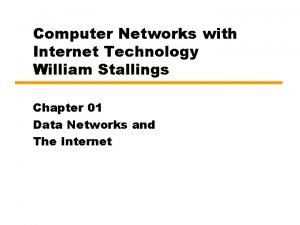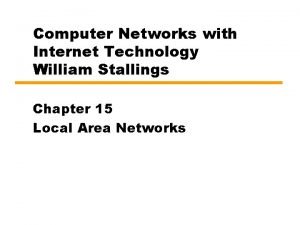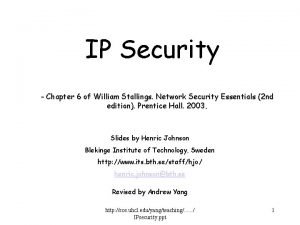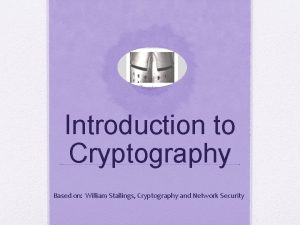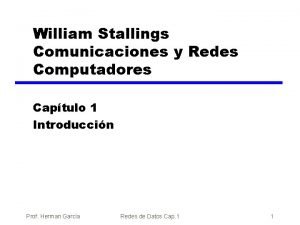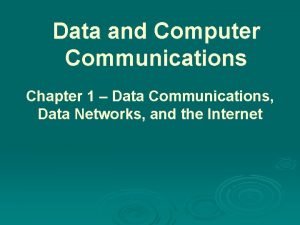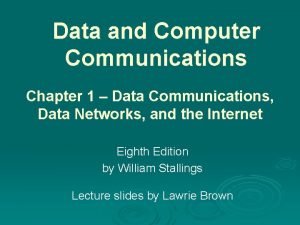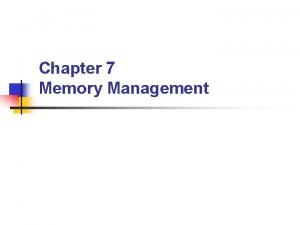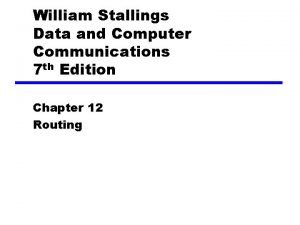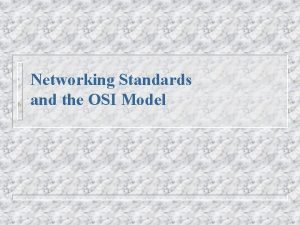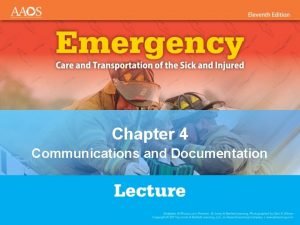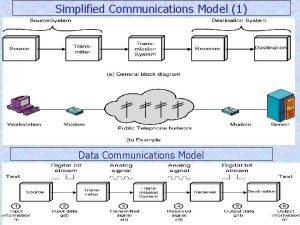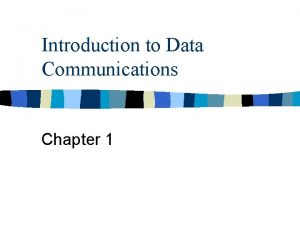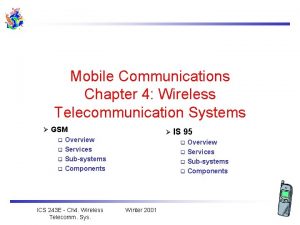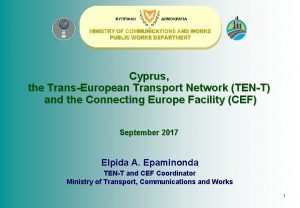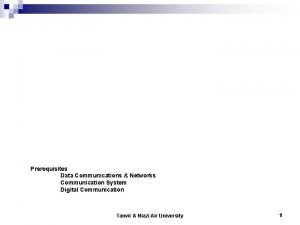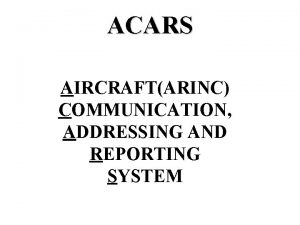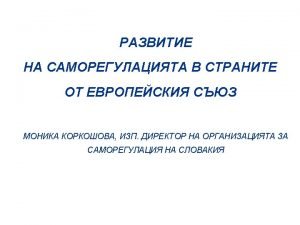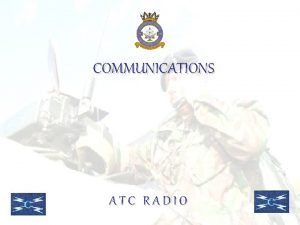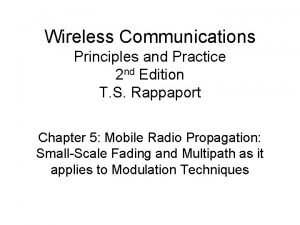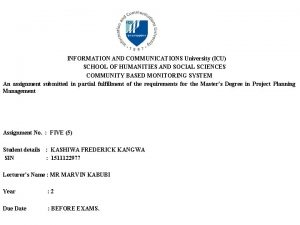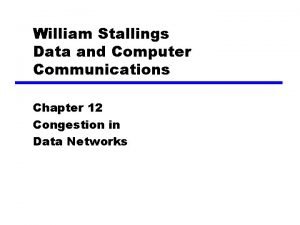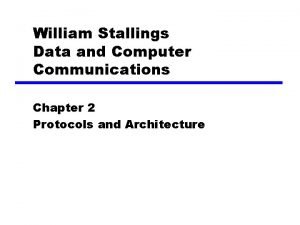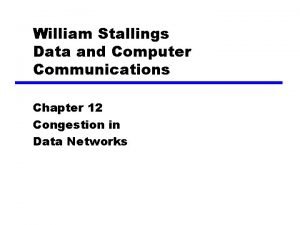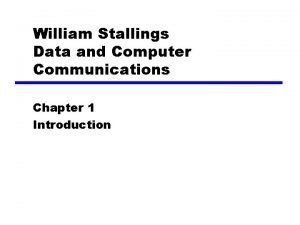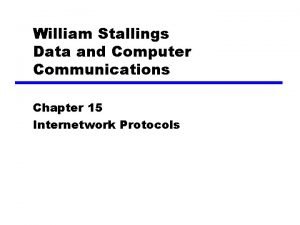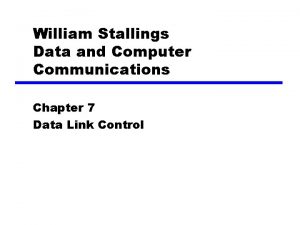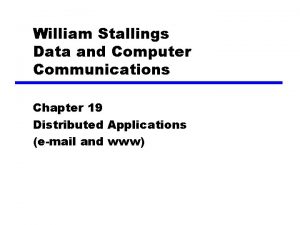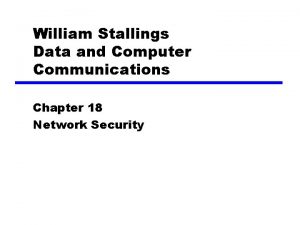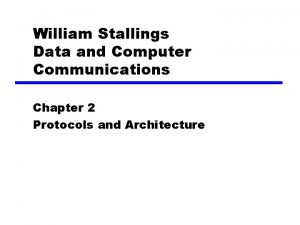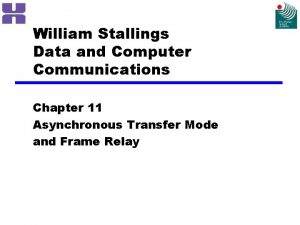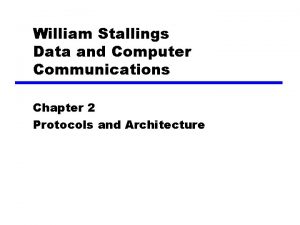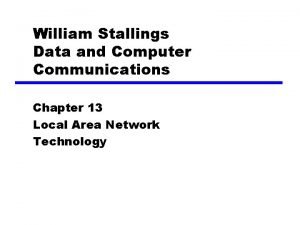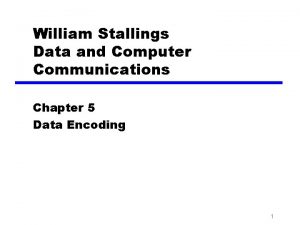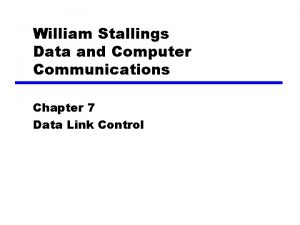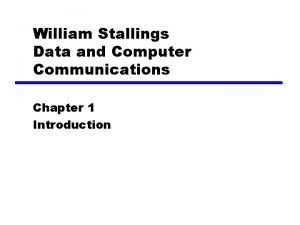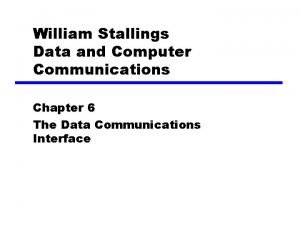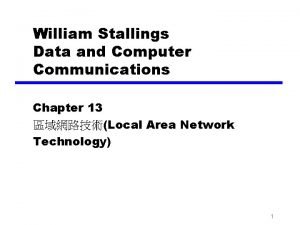William Stallings Data and Computer Communications Chapter 4



















































- Slides: 51

William Stallings Data and Computer Communications Chapter 4 Transmission Media 1

Overview z Guided - wire z Unguided - wireless z Characteristics and quality determined by medium and signal z For guided, the medium is more important z For unguided, the bandwidth produced by the antenna is more important z Key concerns are data rate and distance 2

Design Factors z Bandwidth y. Higher bandwidth gives higher data rate z Transmission impairments y. Attenuation z Interference z Number of receivers y. Major factor in guided media y. More receivers (multi-point) introduce more attenuation 3

Electromagnetic Spectrum 4

Guided Transmission Media z the transmission capacity depends on the distance and on whether the medium is point-to -point or multipoint z e. g. , z Twisted Pair z Coaxial cable z Optical fiber 5

Twisted Pair z consists of two insulated copper wires arranged in a regular spiral pattern to minimize the electromagnetic interference between adjacent pairs z often used at customer facilities and also over distances to carry voice as well as data communications z low frequency transmission medium 6

Twisted Pair - Applications z Most common medium z Telephone network y. Between house and local exchange (subscriber loop) z Within buildings y. To private branch exchange (PBX) z For local area networks (LAN) y 10 Mbps or 100 Mbps 7

Twisted Pair - Pros and Cons z Cheap z Easy to work with z Low data rate z Short range 8

Twisted Pair - Transmission Characteristics z Analog y. Amplifiers every 5 km to 6 km z Digital y. Use either analog or digital signals yrepeater every 2 km or 3 km z Limited distance z Limited bandwidth (1 MHz) z Limited data rate (100 MHz) using different modulation & signaling techniques z Susceptible to interference and noise 9

Unshielded and Shielded TP z Unshielded Twisted Pair (UTP) y. Ordinary telephone wire y. Cheapest y. Easiest to install y. Suffers from external electromagnetic interference (EM) z Shielded Twisted Pair (STP) ythe pair is wrapped with metallic foil or braid to insulate the pair from electromagnetic interference y. More expensive y. Harder to handle (thick, heavy) 10

UTP Categories z Cat 3 yup to 16 MHz y. Voice grade found in most offices y. Twist length of 7. 5 cm to 10 cm z Cat 4 (least common) yup to 20 MHz z Cat 5 yup to 100 MHz y. Commonly pre-installed in new office buildings y. Twist length 0. 6 cm to 0. 85 cm 11

Twisted Pair Advantages z inexpensive and readily available z flexible and light weight z easy to work with and install 12

Twisted Pair Disadvantages z susceptibility to interference and noise z attenuation problem y. For analog, repeaters needed every 5 -6 km y. For digital, repeaters needed every 2 -3 km z relatively low bandwidth 13

Coaxial Cable 14

Coaxial Cable Applications z Most versatile medium z Television distribution y. Aerial to TV y. Cable TV z Long distance telephone transmission y. Can carry 10, 000 voice calls simultaneously y. Being replaced by fiber optic z Short distance computer systems links z Local area networks 15

Coaxial Cable - Transmission Characteristics z Analog y. Amplifiers every few km y. Closer if higher frequency y. Up to 500 MHz z Digital y. Repeater every 1 km y. Closer for higher data rates 16

Coax Advantages z higher bandwidth y 400 to 600 Mhz yup to 10, 800 voice conversations z can be tapped easily (pros and cons) z much less susceptible to interference than twisted pair 17

Coax Disadvantages z high attenuation rate makes it expensive over long distance z bulky 18

Optical Fiber 19

Optical Fiber - Benefits z Greater capacity y. Data rates of hundreds of Gbps z Smaller size & weight z Lower attenuation z Electromagnetic isolation z Greater repeater spacing y 10 s of km at least 20

Optical Fiber - Applications z Long-haul trunks z Metropolitan trunks z Rural exchange trunks z Subscriber loops z LANs 21

Optical Fiber - Transmission Characteristics z Act as wave guide for 1014 to 1015 Hz y. Portions of infrared and visible spectrum z Light Emitting Diode (LED) y. Cheaper y. Wider operating temp range y. Last longer z Injection Laser Diode (ILD) y. More efficient y. Greater data rate z Wavelength Division Multiplexing 22

Fiber Optic Types z multimode step-index fiber ythe reflective walls of the fiber move the light pulses to the receiver z multimode graded-index fiber yacts to refract the light toward the center of the fiber by variations in the density z single mode fiber ythe light is guided down the center of an extremely narrow core 23

Optical Fiber Transmission Modes 24

Fiber Optic Signals fiber optic multimode step-index fiber optic multimode graded-index fiber optic single mode 25

Fiber Optic Advantages z greater capacity (bandwidth of up to 2 Gbps) z smaller size and lighter weight z lower attenuation z immunity to environmental interference z highly secure due to tap difficulty and lack of signal radiation 26

Fiber Optic Disadvantages z expensive over short distance z requires highly skilled installers z adding additional nodes is difficult 27

Wireless Transmission z Unguided media z Transmission and reception via antenna z Two techniques are used: z Directional y. Focused beam y. Careful alignment required z Omnidirectional y. Signal spreads in all directions y. Can be received by many antennas 28

Frequencies z 2 GHz to 40 GHz y. Microwave y. Highly directional y. Point to point y. Satellite z 30 MHz to 1 GHz y. Omnidirectional y. Broadcast radio z 3 x 1011 to 2 x 1014 y. Infrared y. Local 29

Wireless Examples z terrestrial microwave transmission z satellite transmission z broadcast radio z infrared 30

Terrestrial Microwave z uses the radio frequency spectrum, commonly from 2 to 40 Ghz z transmitter is a parabolic dish, mounted as high as possible z used by common carriers as well as by private networks z requires unobstructed line of sight between source and receiver z curvature of the earth requires stations (called repeaters) to be ~30 miles apart 31

Microwave Transmission Applications z long-haul telecommunications service for both voice and television transmission z short point-to-point links between buildings for closed-circuit TV or a data link between LANs 32

Microwave Transmission Advantages z no cabling needed between sites z wide bandwidth z multichannel transmissions 33

Microwave Transmission Disadvantages z line of sight requirement z expensive towers and repeaters z subject to interference such as passing airplanes and rain 34

Satellite Microwave z a microwave relay station in space z Satellite receives on one frequency, amplifies or repeats signal and transmits on another frequency z geostationary satellites yremain above the equator at a height of 22, 300 miles (geosynchronous orbit) ytravel around the earth in exactly the time the earth takes to rotate 35

Satellite Transmission Links z earth stations communicate by sending signals to the satellite on an uplink z the satellite then repeats those signals on a downlink z the broadcast nature of the downlink makes it attractive for services such as the distribution of television programming 36

Satellite Transmission Process satellite transponder dish 22, 300 miles uplink station downlink station 37

Satellite Transmission Applications z television distribution ya network provides programming from a central location using direct broadcast satellites (DBS) z long-distance telephone transmission yhigh-usage international trunks z private business networks 38

Principal Satellite Transmission Bands z C band: 4(downlink) - 6(uplink) GHz ythe first to be designated z Ku band: 12(downlink) -14(uplink) GHz yrain interference is the major problem z Ka band: 19(downlink) - 29(uplink) GHz yequipment needed to use the band is still very expensive 39

Satellite Advantages z can reach a large geographical area z high bandwidth z cheaper over long distances 40

Satellite Disadvantages z high initial cost z susceptible to noise and interference z propagation delay 41

Broadcast Radio z Omnidirectional z FM radio z UHF and VHF television z Requires line of sight z Suffers from multipath interference y. Reflections 42

Infrared z Achieved using tranceivers that modulate noncoherent infrared light z Requires line of sight (or reflection) z Blocked by walls z e. g. TV remote control, Infrared port 43

Common Carriers z a government-regulated private company z involved in the sale of infrastructure services in transportation and communications z required to serve all clients indiscriminately z services and prices from common carriers are described in tariffs 44

Leased (or Dedicated) Lines z permanently or semi-permanently connect between two points z economical in high volume calls between two points z no delay associated with switching times z can assure consistently high-quality connections 45

Leased (or Dedicated) Lines z voice grade channels ynormal telephone lines yin the range of 300 Hertz to 3300 Hertz z conditioning or equalizing yreduces the amount of noise on the line, providing lower error rates and increased speed for data communications 46

T-1 Carrier z also referred to as DS-1 signaling z provides digital full-duplex transmission rates of 1. 544 Mbps z usually created by multiplexing 24 64 -Kbps voice or 56 -Kbps data lines z higher speeds are available with T-3 (45 Mbps) [sometimes referred to a DS-3 lines; can be multiplexed into 28 T-1 signals; T-3 consists of 672 individual channels, each of which supports 64 -Kbps] and T-4 services (274 Mbps) z in Europe, E-1 (2. 048 Mbps) is used instead of T-1 47

Integrated Services Digital Network (ISDN) z all-digital transmission facility that is designed to replace the analog PSTN z basic ISDN (basic rate access) ytwo 64 Kbps bearer channels + 16 Kbps data channel (2 B+D) = 144 Kbps z broadband ISDN (primary rate access) ytwenty-three 64 Kbps bearer channels + 64 data channels (23 B+D) = 1. 536 Mbps 48

Past Criticism of ISDN z “Innovations Subscribers Don’t Need” z “It Still Doesn’t Network” z “It Still Does Nothing” z Why so much criticism? yoverhyping of services before delivery yhigh price of equipment ydelay in implementing infrastructure yincompatibility between providers' equipment. 49

ISDN Channel Definitions z B (bearer) channels y 64 kbps channels that may be used to carry voice, data, facsimile, or image z D (demand) channels ymainly intended for carrying signaling, billing and management information to control ISDN services (out-of-band control messages) ymay be either 16 or 64 kbps 50

Two Levels of ISDN Service z basic rate interface (BRI) y 2 B (64 kbps) + D (16 kbps) = 144 kbps z primary rate interface (PRI) y 23 B (64 kbps) + D (64 kbps) = 1. 536 Mbps x. North American standard y 30 B (64 kbps) + D (64 kbps) = 1. 984 Mbps x. European standard 51
 Simplified data communication model
Simplified data communication model Computer organization and architecture william stallings
Computer organization and architecture william stallings William stallings computer networks
William stallings computer networks William stallings computer networks
William stallings computer networks Network security essentials 5th edition
Network security essentials 5th edition Network security essentials william stallings ppt
Network security essentials william stallings ppt William stallings
William stallings William stallings
William stallings Stallings william comunicaciones y redes de computadores
Stallings william comunicaciones y redes de computadores Cryptography william stallings
Cryptography william stallings Data and computer communications 10th edition
Data and computer communications 10th edition Data and computer communications
Data and computer communications Data and computer communications
Data and computer communications Fixed partitions
Fixed partitions Stallings garbage pickup
Stallings garbage pickup Daphne ovid
Daphne ovid Metodo stallings
Metodo stallings Least cost routing algorithm
Least cost routing algorithm Telecommunication meaning
Telecommunication meaning Business data communications and networking
Business data communications and networking Business data communications and networking
Business data communications and networking Introduction to data communications and networking
Introduction to data communications and networking Business data communications and networking
Business data communications and networking Networking standards organizations
Networking standards organizations Chapter 4 communications and documentation quiz
Chapter 4 communications and documentation quiz Chapter 3 network protocols and communications
Chapter 3 network protocols and communications Simplified communications
Simplified communications Introduction to data communications
Introduction to data communications A fire department communication center functions
A fire department communication center functions Communications chapter
Communications chapter Objectives of computer system
Objectives of computer system What is computer organization
What is computer organization Input devices
Input devices Difference between computer architecture and organization
Difference between computer architecture and organization Track and report nims
Track and report nims Orient east med corridor
Orient east med corridor Global marketing communications
Global marketing communications Amplified expressiveness
Amplified expressiveness Digital communications and networks
Digital communications and networks K state communications and marketing
K state communications and marketing Business communications process and product
Business communications process and product Business communications process and product
Business communications process and product Acars label
Acars label Designing and managing integrated marketing communications
Designing and managing integrated marketing communications Monitor communications process tools and techniques
Monitor communications process tools and techniques Attitudes and persuasive communications
Attitudes and persuasive communications Easa advertising
Easa advertising Atc communications and radio procedures
Atc communications and radio procedures Managing integrated marketing communications
Managing integrated marketing communications Sircim
Sircim List of lecturers at icu zambia
List of lecturers at icu zambia Tactical communication skills
Tactical communication skills


